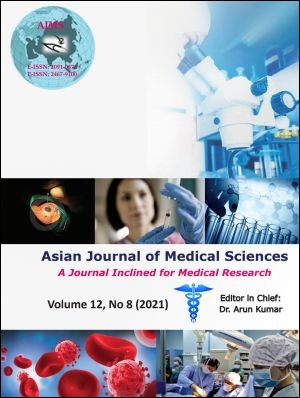Selective episiotomy versus no episiotomy – A clinical study on primigravida
Keywords:
Episiotomy, Wound haematoma, Wound dehiscenceAbstract
Background: Episiotomy is the incision given over the pudendum, i.e. on the external genitalia organ during the vaginal delivery.
Aims and Objective: In this study it has been tried to evaluate the benefits and the risks of selective episiotomy over spontaneous lacerations.
Materials and Methods: This is an institution based interventional longitudinal study carried out in the Department of Obstetrics & Gynaecology of College Of Medicine & JNM Hospital, Kalyani over a period of 18 months in 218 patients (109 in each group) fulfilling the inclusion criteria. The recruitment and allocation in episiotomy and non-episiotomy groups were random after proper consent from the participants.
Results: The frequency of postpartum perineal pain was around 47% in no episiotomy group and around 60% in selective episiotomy group. There were no cases of dehiscence, haematoma or wound infection in either of the groups. Around 96.22% of the women in the non-episiotomy group were satisfied or very satisfied compared to 89.52% in the selective episiotomy group.
Conclusion: An episiotomy rate of less than 1% found in no episiotomy group as compared to around 18% episiotomy rate in selective episiotomy group. However, they have almost same feto-maternal outcome which successfully establish the effectiveness of no episiotomy practice over the selective one.
Downloads
Downloads
Published
How to Cite
Issue
Section
License
Copyright (c) 2021 Asian Journal of Medical Sciences

This work is licensed under a Creative Commons Attribution-NonCommercial 4.0 International License.
Authors who publish with this journal agree to the following terms:
- The journal holds copyright and publishes the work under a Creative Commons CC-BY-NC license that permits use, distribution and reprduction in any medium, provided the original work is properly cited and is not used for commercial purposes. The journal should be recognised as the original publisher of this work.
- Authors are able to enter into separate, additional contractual arrangements for the non-exclusive distribution of the journal's published version of the work (e.g., post it to an institutional repository or publish it in a book), with an acknowledgement of its initial publication in this journal.
- Authors are permitted and encouraged to post their work online (e.g., in institutional repositories or on their website) prior to and during the submission process, as it can lead to productive exchanges, as well as earlier and greater citation of published work (See The Effect of Open Access).




